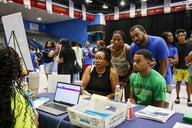You have /5 articles left.
Sign up for a free account or log in.
My first week on the job as Director of IT Policy at Cornell University in 2001, a manager in systems, Sarah, invited me into her office. After some meet and greet, she asked me what I knew technically about the Internet. Not much, I admitted. My husband was an electrical engineer. Forever I owe him gratitude for teaching me about it while I was in law school as well as providing me with a modem and an I.B.M. computer (while he used Apple :-). But because he worked on semi-conductors, I could better describe the gallium-arsenide atomic layering of a transistor than I could explain anything technological about the Internet. So Sarah pull out a piece of paper, grabbed a pen and drew seven parallel lines. It was my introduction to the OSI model of the Internet.
A few years later, after the opening of the Berkman Center at Harvard’s Law School and the publication of Professor Lessig’s groundbreaking work, Code, I attended a two or three day workshop at Stanford University featuring Professor Lessig among other Berkman luminaries who grappled with the intersection of law, economics, user interface and, of course, technology. Professor Lessig, famous for his PowerPoint presentations that were often the collection of single words, photographs or quotes on each slide around which he built his story, included one slide with a three-layered model of the Internet. On the bottom was the physical layer, next came the “logical” layer or protocols, and on top sat the applications layer. This is good, I thought, something I could use for the course I was teaching at Cornell in the Computer Information Science program (now a department) called “Culture, Law and Politics of the Internet.”
Populated by many students from arts and sciences, communications and computer science, as well as the occasional law student, I sought means to bring students from such diverse academic backgrounds to a mutually workable understanding the Internet so as to create a common language around which we could structure course themes in intellectual property, communications law and privacy. I could see the graphic in my mind immediately: set the seven layered computer science/engineering model across from this three layered interpretation, draw a few lines from seven to three to consolidate layers. And the class process: I would call upon the comp sci students to briefly describe the seven layers – because heaven knows they knew them better than I ever would – and then ask the non-technical students to explain how that model converted into the “lay persons” model of the Internet. With full credit and compliments to my students over six semesters, it worked well as a class exercise every time.
Last week I attended Internet2’s Global Summit in Denver, Colorado. It was excellent. (In my next life, I want to be President Shirley Jackson!) For the purposes of this blog, I want to call out the third plenary session, however, as truly over the top. It was the probably the best plenary session of any conference I have ever attended. I was blown away by it, and I didn’t even understand it! (Sorry Professor Lessig, erstwhile at EDUCAUSE … I may have already been too familiar with your work to have experienced the “blown away” affect, but it was a close second for sheer performance. :-). Let me attempt to describe briefly what was so transformative about it.
To quote: we – anyone who pays attention to the phenomenon of the Internet, and in this case in particular, the technology undergirding it – are witnesses to the end of the ISO model. I genuinely look forward to the release of the video of that session. When I watch it again, and I suspect again and again, it will not be in my usual mode of washing the dishes as I do. I will sit as a good student, with old-fashioned pencil and paper by my side, taking notes, pausing to allow concepts and acronyms sink in. For not only did the speakers, Professor Larry Peterson primarily, but all of them together, declare the end of the old model, they sketched out what the new model means, and sort of looks like. That’s what I want to take my time to learn, so I can attempt to capture the equivalent of a graphic that demonstrates the multidimensional transformation. From that graphic I will make the connections, extrapolate out, to law, policy and culture of the Internet. (By the way, if you want to watch it too, keep your eyes peeled for link from the main conference keynote site: http://meetings.internet2.edu/2014-global-summit/featured-keynotes/)
To give you a measure of my excitement, I can say that this was the first time since I entered this work world that I honestly wished I had at least a fundamental knowledge of computer science. I remember not long after I began teaching I did a trade with a student. I loaned him a bunch of books on copyright and he loaned me his basic text in networking. At a bar, Just a Taste in Ithaca, I sat for better than three hours one night nursing a few glasses of wine while getting at least an elementary understanding of network protocols, TCP/IP, and how routers and switches work. I have had colleagues, Stacy Pendell in particular, show me “code,” as well as my son, Nikko, who long before the recent literacy guidelines, told me that code should be a part of elementary education. But I have never felt so deeply the urge to understand the technology of the Internet as I did sitting in that session, aware, even if I did not understand fully the details, that we are on the brink, or at, a moment of real significance.


